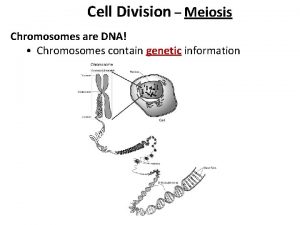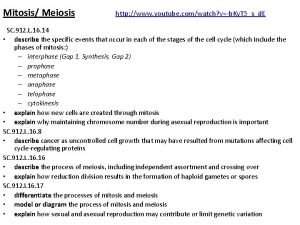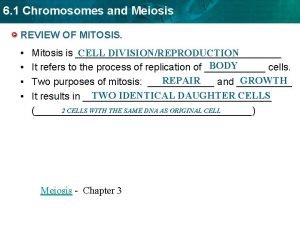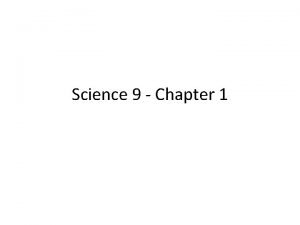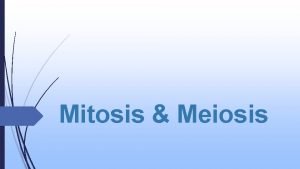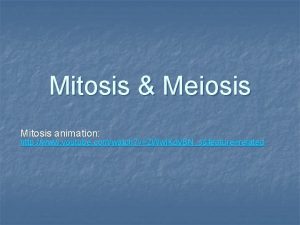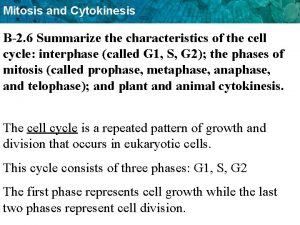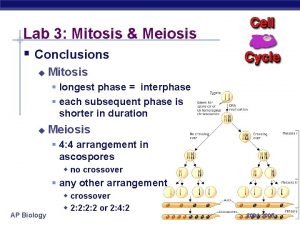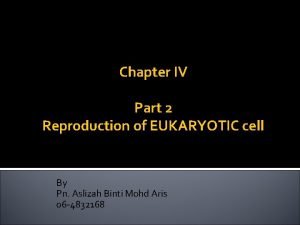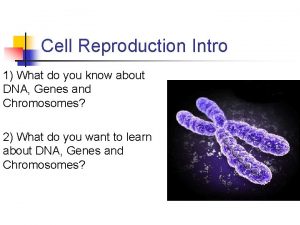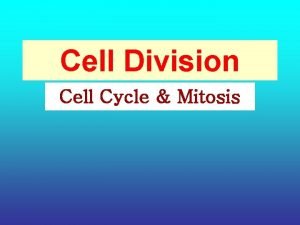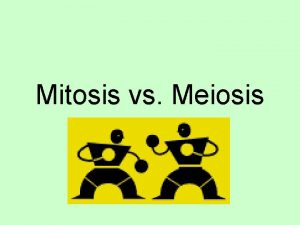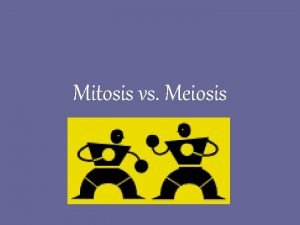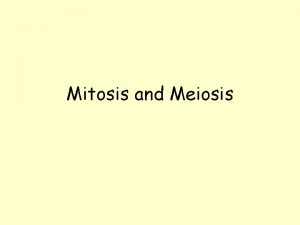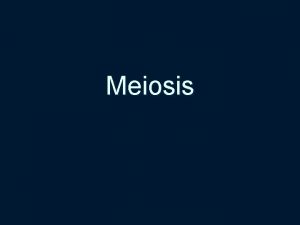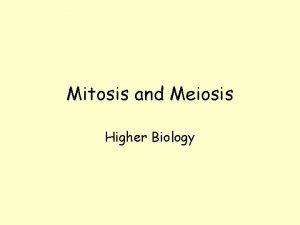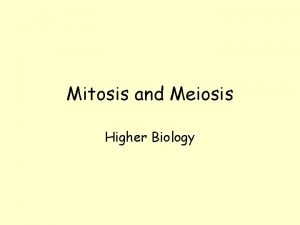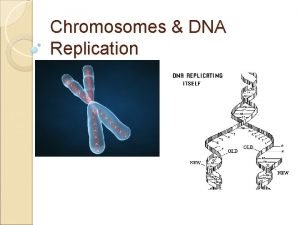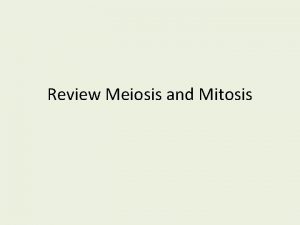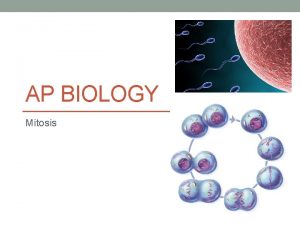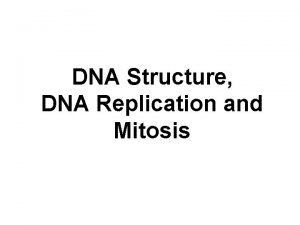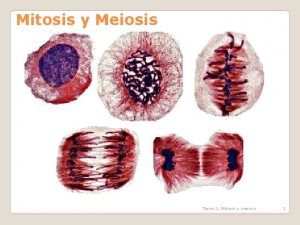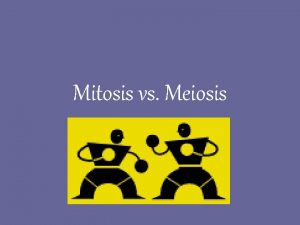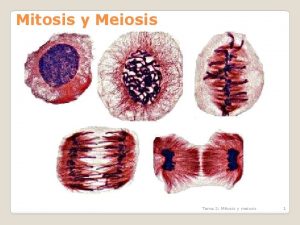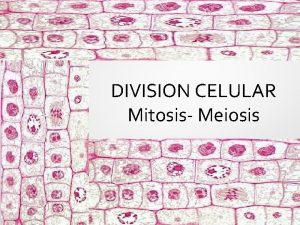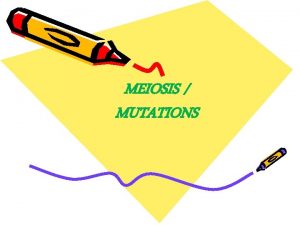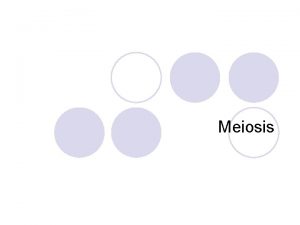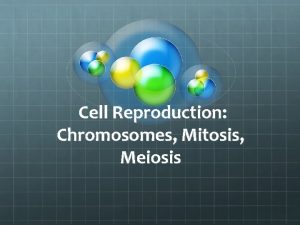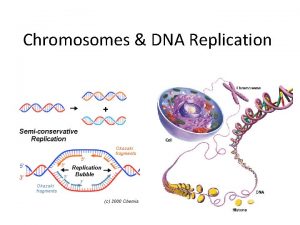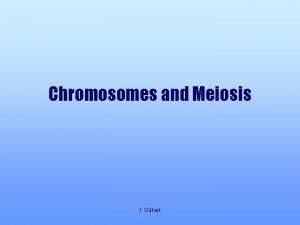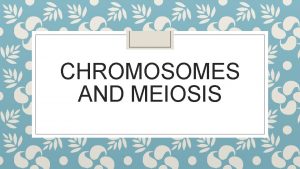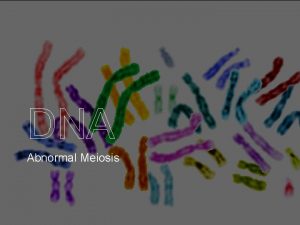Chapter 7 Chromosomes Mitosis and Meiosis Chromosomes DNA





























- Slides: 29

Chapter 7 Chromosomes & Mitosis and Meiosis

Chromosomes • DNA coiled around proteins forms chromosomes DNA Double Helix- DNA Coiled Chromatid around Proteins Super Coil Chromosome

DNA Coiling

Parts of a Chromosome • Each half of a chromosome is called a chromatid • Chromatids are held together at a point called the centromere

Genes • Genes are segments of DNA in chromosomes that code for proteins • Each chromosome contains hundreds of genes

Gametes • Gametes are an organisms sex cells or reproductive cells • Male gamete = sperm • Female gamete = egg • Each gamete only contains half the number of chromosomes of regular cells

Sets of Chromosomes • Humans have 23 pairs of chromosomes, 46 total chromosomes • Humans have 2 copies of each chromosome • 2 exact copies of a chromosome are called Homologous Pairs

Fertilization • Fertilization is the joining of male and female gametes, egg + sperm

Haploid & Diploid Cells • Haploid Cells(n) - have ½ the number of chromosomes of other cells (egg&sperm) • Diploid Cells(2 n) - have 2 copies of all chromosomes (regular human cells) Egg – haploid(n) - Sperm haploid(n) - Fertilized Egg Diploid(2 n)

Types of Chromosomes • Autosomes- the 22 pairs of chromosomes that do NOT determine the sex of an organism • Sex Chromosomes- the 23 rd pair of chromosomes that determines the sex of an individual (X & Y chromosome) XX = female XY = male

Changes in Chromosome # • If an individual has more or less than 46 chromosomes, a genetic disorder may result Ex: Trisomy-21 (Down Syndrome) - a person with trisomy-21 has 3 copies of chromosome #21 - Mutations in chromosomes may also cause genetic disorders

Trisomy-21

Karyotype • A karyotype is a picture of an organisms chromosomes • Karyotypes can be used to detect genetic disorders and chromosome abnormalities

The Cell Cycle • The cell cycle is a repeating process in which a cell grows, copies it’s DNA, and then divides

Cell Cycle Diagram G 1 (gap 1) - Cell Growth S (synthesis) - DNA Synthesis Cytokinesis G 2 (gap 2) M (mitosis) - Cell Division - Cell Growth • G 1 - cell grows • S- DNA is copied • G 2 - growth & preparation for mitosis • M- cell divides • Cytokinesis- point when 2 new cells split apart • Apoptosis- cell death

Cancer • Normal body cells that begin to grow & divide uncontrollably become cancer cells • Carcinogen- a substance that causes cancer – Ex: radiation(x-ray, UV-rays), chemicals, viruses

Mitosis • Mitosis is the process of making exact copies of cells Phases of Mitosis: 1) Prophase- * *

Phases of Mitosis 2) Metaphase- * *

Phases of Mitosis 3) Anaphase- * *

Phases of Mitosis 4) Telophase-

Cytokinesis • 2 exact copies of the original are formed

Interphase • Interphase is the phase when a cell is resting and growing, not dividing • Cells spend most of their time in interphase


Meiosis • Meiosis is the process of forming sex cells (gametes) • Gametes: Male = sperm Female = egg - Meiosis produces haploid(n) cells, cells that have only one copy of each chromosome - Egg & Sperm cells only have 23 chromosomes each

Spermatogenesis • Spermatogenesis makes 4 sperm cells in males Diploid(2 n) Parent Cell Meiosis II Immature Sperm Cells Haploid(n) Sperm Cells

Oogenesis • Oogenesis makes egg cells in females – makes 1 egg Diploid(2 n) Parent Cell Polar Body Polar Bodies Meiosis II * All Polar Bodies Die Secondary Egg Cell Haploid(n) Egg Cell

Genetic Recombination • Often during meiosis pairs of homologous chromosomes exchange pieces of DNA before they separate into daughter cells • This exchange of genetic material is called Crossing Over • Crossing over results in variation in the traits passed on to offspring

Crossing Over

END OF CHAPTER 7 NOTES
 Crossing over in meiosis and mitosis
Crossing over in meiosis and mitosis Independent assortment in meiosis
Independent assortment in meiosis Meiosis 1 vs meiosis 2
Meiosis 1 vs meiosis 2 Chromosomes number is maintained mitosis or meiosis
Chromosomes number is maintained mitosis or meiosis Meiosis and genetic variation answer key
Meiosis and genetic variation answer key Section quick check chapter 10 section 1 meiosis answer key
Section quick check chapter 10 section 1 meiosis answer key Chapter 10 meiosis 1 and meiosis 2 answer key
Chapter 10 meiosis 1 and meiosis 2 answer key Venn diagram of mitosis and meiosis
Venn diagram of mitosis and meiosis Compare meiosis and mitosis
Compare meiosis and mitosis Whats the difference between mitosis and meiosis
Whats the difference between mitosis and meiosis Keslerscience
Keslerscience How are mitosis and meiosis similar
How are mitosis and meiosis similar Concept map of mitosis and meiosis
Concept map of mitosis and meiosis Mitosis meiosis animation
Mitosis meiosis animation Summarize mitosis
Summarize mitosis Diploid
Diploid Conclusion of mitosis and meiosis
Conclusion of mitosis and meiosis Meosis cycle
Meosis cycle Chromosomes in organisms
Chromosomes in organisms Chromosome sets (=n) in mitosis and meiosis
Chromosome sets (=n) in mitosis and meiosis Characteristics of mitosis and meiosis
Characteristics of mitosis and meiosis Mitosis and meiosis
Mitosis and meiosis Anaphase meaning
Anaphase meaning Difference between meiosis 1 and meiosis 2
Difference between meiosis 1 and meiosis 2 Cell division mitosis and meiosis
Cell division mitosis and meiosis Anapjase
Anapjase Mitosis vs meiosis double bubble compare and contrast
Mitosis vs meiosis double bubble compare and contrast Mitosis and meiosis reflection
Mitosis and meiosis reflection Mitosis jeopardy
Mitosis jeopardy Meiosis and mitosis animation
Meiosis and mitosis animation
